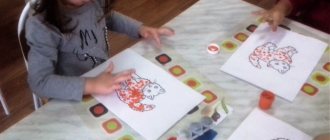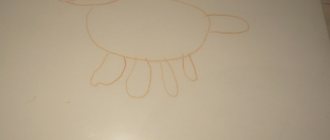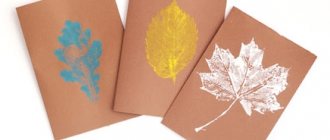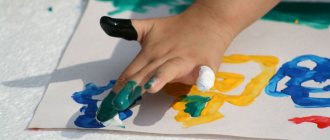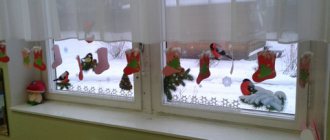Notes on drawing in the second junior group “Hare in winter”
Yosypiv Ekaterina
Notes on drawing in the second junior group “Hare in winter”
Goal: To consolidate children’s knowledge and ideas about the change in color of a hare in winter , to continue to teach children to draw round objects .
• consolidate children's knowledge about the life of wild animals in winter;
• learn to draw round objects;
• Enrich children's vocabulary and develop the ability to describe an animal using adjectives: the fur coat is white, fluffy, warm, soft, the ears are long, the tail is short;
• develop thinking, creative imagination;
• develop fine motor skills of the hands.
• cultivate kindness and responsiveness;
• develop the ability to work with paint carefully;
Preliminary work: Examination of illustrations depicting a hare in winter .
chairs (according to the number of children)
;
Letter from the Hares;
Layout " Winter Forest "
;
Audio speaker with the musical game “The Fox and the Hares”
;
gouache white, black, color (according to the number of children)
;
tassels (according to the number of children)
;
sheets of blue paper, A-5 format (according to the number of children)
;
a glass of water (according to the number of children)
;
oilcloths (according to the number of children)
;
Abstract of GCD in junior group 1: Wild animals in winter
Lesson on a winter theme in the 1st junior group.
Abstract Author: Bykova Natalya Ivanovna, teacher. Place of work: MDOU “Child Development Center - kindergarten No. 110 “Little Red Riding Hood”, Petrozavodsk, Republic of Karelia.
Direct educational activities in the 1st junior group.
Topic: “Wild animals in winter.” Educational areas: “Social and communicative development”, “Cognitive development”, “Speech development”, “Physical development”. Goal: To give children an idea of wild animals, their characteristics, habits, and nutrition. Objectives: 1. “Cognitive development”: To form in children ideas about animals - inhabitants of the forest (hare, squirrel, fox, wolf, bear), their appearance, nutrition, and lifestyle features. Talk about how a bear prepares for winter. 2. “Speech development”: Develop children’s speech, the ability to listen to the teacher, answer questions, repeat after the teacher. Develop the ability to solve riddles. Enrich children's vocabulary. Vocabulary work: winter, forest, fox, bear, hare, wolf. 3. “Social-communicative”: Contribute to the creation of a favorable psychological atmosphere in the classroom. Arouse interest in playing together with an adult. Develop the ability to build dialogue with adults and peers. Cultivate interest and love for animals, a desire to care for them. 4. “Physical development”: Learn to move, imitating movements characteristic of a fox, wolf, hare. Develop coordination of movements. Methodological techniques: visual, verbal, game, guessing riddles, artistic expression, questions, surprise moments, musical (“lullaby”). Preliminary work: Learning songs and poems on the theme of wild animals. Situational conversations on this topic. Looking at illustrations of “wild animals”. Russian folk game “Fox and Hares”, “The gray bunny is sitting”, “The bunny is jumping, jumping”. Equipment and material: Composition “Winter Forest”;
wild animal toys: hare, fox, wolf, bear, squirrel; basket; treat for animals: a barrel of honey, raspberries, a toy fish, mushrooms, nuts, meat (a replica from the game “shop”). Progress:
The teacher invites the children to go into the forest.
Educator: Guys, do you want to go into the forest with me? Wild animals live in the forest. Let's get them a treat. On the table are dummies for playing shop: raspberries, a barrel of honey, a toy fish, carrots, mushrooms, nuts, meat. The teacher offers to put all the products in a basket. Children name each item and put it in a basket. Educator : It’s winter now, there’s a lot of snow in the forest. And it’s hard for us to walk in the snow! Let's sit down quietly and I'll tell you a poem about a bear. You can’t find a bear’s trail in winter, Zimushka sent Mishenka to bed. In the den he sucks a sweet paw, And he dreams that he eats honey. Mishka purrs contentedly with joy. Hey, animals, be quiet... Let Misha sleep. (Gusarova T.) The teacher draws the children’s attention to a bear cub lying under a tree. Educator: Hush, children, the bear is sleeping! You won’t see him in the forest in winter, because the bear sleeps in a den for the winter. To make the bear sleep better, let's sing him a lullaby. Children with a teacher sing “Lullaby”, music. E. Tilicheeva, lyrics. N. Naydenova. 1. Bye-bye, bye-bye! Sleep, my teddy bear, go to sleep. 2. Hurry up and close your eye. Get some sleep, get some sleep for an hour. 3. Bye-bye, bye-bye! Sleep, my teddy bear, sleep! The children sing along and lull the bear to sleep. Educator: Guys, what will we give the bear as a gift, what kind of treat? Children choose raspberries and honey, take them out and leave them next to the teddy bear. Educator: The bear will wake up, see raspberries and honey and be happy. Let the little one sleep, and you and I will take a walk through the winter forest. We will walk quietly so as not to wake the bear. The teacher shows a toy hare. Educator: Oh, look, children, who we met in the forest! Who is this? (bunny) What kind of bunny? (white, soft, fluffy). In winter, the bunny's fur is white as snow, so that the wolf and the fox would not notice him in the snow and would not catch him. What kind of ears does the hare have? (long, sensitive - hear well). The bunny wants to play with you. Game with the Hare. There is a snowball on the ground (they run on their toes in a circle) The bunny runs through the snow. Jump - hop, jump - hop (they jump like bunnies) The bunny runs through the snow. Ears are freezing (stroke ears), Paws are freezing (stroke hands). Without boots and without a hat. (show) Jump - hop, hop - hop, (jump like bunnies) The bunny hid in a snowdrift. (squat down). Educator: The bunnies jumped merrily. What will we give the bunny, what does he like to eat? Children choose a carrot and give it to the hare. Educator: Let's say to the bunny: “Eat, bunny, a carrot!” Educator: The hare was delighted with the gift and galloped further into the forest. The bunny runs fast and fast. Educator: Here is a little fox running - her red sister. The teacher shows the children a toy fox. Educator: The fox also doesn’t want to wake up the little one. She walks quietly, on her toes. Can you walk like that? Show it to the fox. Children do an exercise, imitate a fox. Educator: Guys, what kind of fur coat does the fox have? (red, fluffy) What kind of tail does the fox have? (long, fluffy, big). The fox really enjoyed playing with the guys. Shall we treat the fox? What will we choose for the fox? Children choose a fish and treat the fox. Educator: Let's say to the fox: “Eat, little fox, fish!” Educator: The little fox played and ran into the forest to eat fish. Educator: Listen, what forest animal is the riddle about: On a cold, gloomy winter day, a hungry beast walks and wanders. He prowls through forests and fields, And he looks for food for himself. Who is this? (wolf). The teacher shows a toy wolf. Educator: A wolf is hunting in the forest. He walks carefully so as not to frighten other animals. Show how a wolf makes its way through the forest. Children imitate the movements of a wolf. Educator: The wolf is a strong beast. What kind of fur does he have? (thick, gray). What kind of teeth does a wolf have? (spicy). What will we treat the wolf to, what will he like most? (we'll treat you to meat). Educator: Let's say: “Help yourself, little top, gray barrel!” Educator: The gray wolf ran further into the forest to hunt. Educator: It seems like some animal is sitting on a tree. Who is this? The teacher shows a toy squirrel. Educator: Who is this? (squirrel). What squirrel? (fluffy, small). What kind of tail does a squirrel have? (big, fluffy-fluffy). A squirrel lives in a hollow in a tree. She jumps from one tree to another. What does the squirrel like, what can we treat it to? (mushrooms, nuts) Children treat the squirrel. Educator: Let's say: “Help yourself, squirrel! Eat mushrooms and nuts!” Educator: The squirrel climbed onto the highest tree. The wolf won't get her, the fox won't get her. What a clever squirrel. Educator: Children, do you think we didn’t wake up the bear? Let's hear if the bear is growling? Children listen. Educator: You played so quietly that the little one didn’t even wake up. Did you enjoy a walk in the winter forest? Let's remember who lives in the forest? The teacher quietly puts a bag of carrots in the basket. Educator: Now it’s time for us to return to the group. Oh, look, guys, there’s something in our basket. What is this? (carrot). Who do you think put this on us? (bunny). The bunny also wants to treat you. Help yourself to some carrots! Let's say "thank you" to the bunny! It's time for us to return to the group.
We recommend watching:
OD summary on sensory development in the junior group on the topic: Winter Summary of a lesson in the 2nd junior group on the topic: Winter Summary of a lesson on cognitive development in the 2nd junior group on the topic: Winter Summary of a lesson on speech development on the topic: Winter in the 2nd junior group
Similar articles:
Summary of a game lesson for young children on the topic: Winter
Summary of a drawing lesson in the nursery group “Forest Dwellers”
Sofia Shvorak
Summary of a drawing lesson in the nursery group “Forest Dwellers”
Summary of a drawing lesson in the nursery group “ Forest Dwellers ”
1. expand children’s ideas about wild animals, their appearance, habits
2. forming a positive attitude towards them
3. teach to distinguish animals (by color, size)
Material: Demonstration pictures depicting wild animals (fox, hare, bear)
Silhouettes of animals cut out of white cardboard
Progress of the lesson.
Educator: Guys, listen to the nursery rhyme and you will find out who came to visit us.
Educator: That's right, bunny!
There is a knock on the door.
Educator: I wonder who else came to us?
He brings in the fox: the teacher puts a bi-ba-bo doll on his hand and says on her behalf: “Hello! Whoa, who do I see (a hare, I want to play hide and seek with you. I will turn my back, and you hide."
Educator: Guys, let's help the bunny, otherwise the fox will catch him and eat him! Shall we help the bunny?
Educator: What can we do to save the bunny?
Children's answers. The teacher praises and selects the most successful and inventive answers.
Educator: It’s winter outside, everything is covered with white snow . And the little hares in their gray fur coat stand out against the white snow .
Educator: What color is the fur of bunnies in winter?
Educator: Correct. A white fur coat is needed so that the hare is not visible in the snow . What other kind of fur do rabbits have?
Children: She is fluffy and soft.
Educator: Well done! In order for our bunnies to have the same fur, you need to pick up a little white gouache with a dry, hard brush, and, holding the brush vertically, make pokes on top inside the outline.
drawing methods .
Independent activity of children.
At the end of the lesson, the results are summed up .
Educator: Well done! Look what beautiful white and fluffy bunnies you have made! Well, little fox, you can look for bunnies!
Fox (addressing the children)
: “Now I’ll quickly find the hares.
(Looks at the children's work)
. Where are they? Well, again I couldn’t catch the rabbits. "
Educator: “Well done, guys! They helped the bunnies well.”
Photo report on a drawing lesson with children aged 5–6 years on the topic “Hare in the Snow” Our bunnies are fashionistas, They have changed their frock coats: Nowadays the hares are white, Even though they were grey. In autumn it is easier for gray people to live among gray nature, and in winter it is calmer.
Abstract of an integrated GCD on the topic “Wild animals. Hare" (early age) Purpose: Introducing children to wild animals. Objectives: To introduce children to wild animals; Teach children to understand the question and answer it;
Summary of educational activities for children of the second junior group “Let's help the squirrel. Wild animals" Problems. To consolidate children’s ideas about autumn, its characteristic features, and autumn natural phenomena. Reinforce the concept of “wild animals”.
Abstract of the GCD in the second junior group “Wild animals and their young” Purpose: to summarize children’s ideas about wild animals and their young. Objectives: Educational: Consolidating ideas about features.
Summary of educational activities “Wild and domestic animals.” For the second younger group, a summary of educational activities with preschool children: in the field of “Cognitive development.” For the second younger group. By.
Abstract of an OD on drawing in the second junior group “Trees in the Snow” MBDOU Kindergarten No. 5 “Kalinka” p Enem Republic of Adygea Abstract of an OD on drawing in the 2nd junior group “Trees in the Snow” Higher education teacher.
Source
